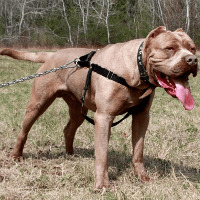Appearance of the American Bandogge
|
| These dogs, with their short, rough, thick coats, are very muscular and rectangular in shape, with fine, tapering tails. Their bodies are well proportioned, with triangular ears and protruding lips. The American Bandogge has large eyes that can be dark or similar to the color of its coat. It has the compact body typical of a Mastiff and a structure similar to that of a large Pit Bull. The head is broad and square, with a strong chest and broad shoulders. They will have a strong, robust, muscular neck and impressively strong jaws. These hybrid dogs come in many colors, including brindle, blue or navy, fawn, red and black, and all can be mixed with white. Breeding all-white dogs is generally not recommended. Their noses can be black or red. As with most dog breeds, males are slightly larger and heavier than females. |
Temperament of the American Bandogge
|
| The American Bandogge is an extremely intelligent dog. It is confident and very docile. Like all Mastiffs, they need masters capable of remaining dominant over dogs. They are generally not recommended for new dog owners, as they need someone who really understands canine instinct and knows how to communicate correctly what you expect from them. Although they are not bred as fighting dogs, if they find themselves with a passive owner who doesn't know how to communicate that aggression is not acceptable, they can become aggressive dogs. Some people, mainly on the East Coast, still use this dog as a fighting dog. Fortunately, more and more people are breeding these dogs for protection rather than fighting. As a protection dog, they are on the whole excellent. They have a lot of energy and are very docile. The only drawback to their temperament for protection work is their reluctance to perform the barking part of the bark and hold exercise. Since they come from a fighting line, most dogs in this line don't bark as a warning; this task is generally difficult. The American Bandogge is an attention-loving breed that thrives on leadership. If you're not this dog's 100% pack leader and/or don't provide sufficient mental and physical exercise, he'll be very upset when left alone and will be difficult to control. Although they are happy to receive attention and readily accept anything you give them, they absolutely need a master who is authoritative towards them. They prefer to be with their masters and live to please and protect them, loving their family and protecting their domain. Bandogues can get along with other animals if raised with them, including kittens, cats and other dogs, but they can be aggressive with animals they haven't been socialized with. They will protect themselves and their family to the end. Confident and very obedient, they are excellent with children. Bandogues seem to have a sense of when to be gentle. They are excellent family members, but also an intruder's worst nightmare. They are said to be silent peacekeepers. This breed can drool and salivate. |
Needs and activities of the American Bandogge
|
| This breed is known for being highly intelligent and confident, but also quite docile. However, it will need masters who can clearly show that they are the leaders and can remain dominant. If not matched with the right master, these dogs can become aggressive towards other dogs. For this reason, they are not recommended for new dog owners, as they will need someone who knows how to communicate. Unfortunately, in some parts of the East Coast, these dogs are used for fighting. But there are more people who use these dogs for protection, which they excel at. They can be difficult to control and can become upset when left alone for long periods, unless they receive sufficient exercise, both physical and mental, and have a master who directs them properly. The American Bandogge will live happily with other pets if it has been raised and properly socialized with them, but it won't get on as well with animals it doesn't know. As these dogs are obedient, loving and protective of their family, they get on very well with children. Because of their gentle but protective nature, they are ideal as family and guard dogs. |
Maintenance of the American Bandogge
|
| These dogs can live well in apartments, but only if they get enough exercise. With enough activity, both mental and physical, the American Bandogge will not become destructive or lazy. They are quite active when indoors, so don't necessarily need a large garden, although they will certainly appreciate one if it's available. This breed will enjoy accompanying its owner on daily walks. They shed moderately, but are easy to groom. Use a rubber brush to remove loose or dirty hair two or three times a week. This breed can be dominant, but with a confident and experienced master, it can be very obedient and easy to train. Feed your dog twice a day and make sure his water is fresh and always available, as he drools a lot. These dogs are like any others in that they need regular brushing of their teeth and trimming of their nails. For dental care, it's best to do it every day, but once or twice a week is enough at the very least. As for nail trimming, once or twice a month is often sufficient. |









 English (United Kingdom)
English (United Kingdom)